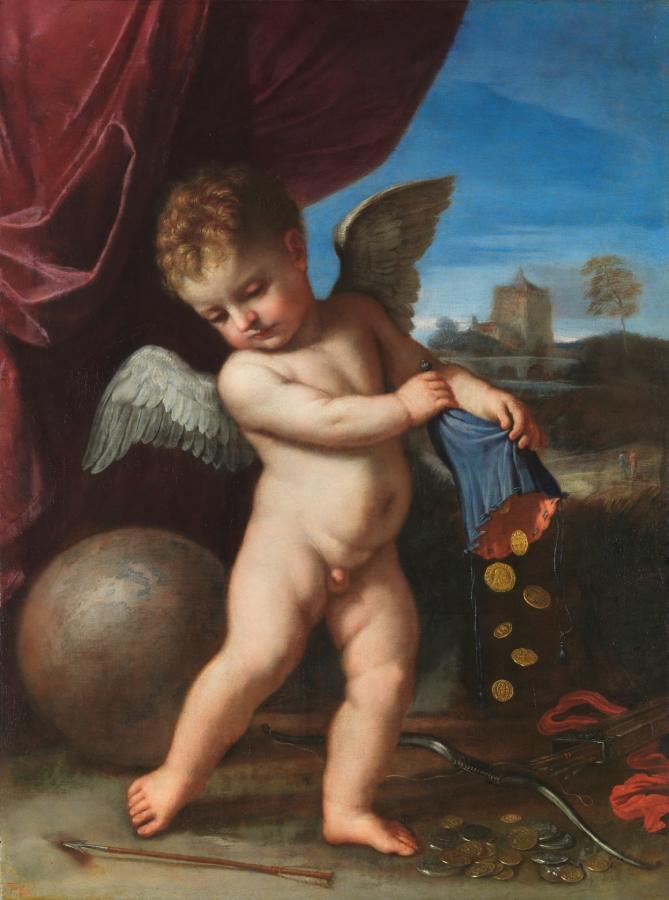Guercino (1591-1666)
Amor virtuoso (Cupid Spurning Riches)
c.1653
Oil on canvas, 99 x 75 cm
Museo del Prado, Madrid
The papal nuncio to Spain, Camillo Massimo (1620–1677), presented Guercino’s Cupid spurning Riches and Guido Reni’s Cupid with a Bow (P150) to King Philip IV as diplomatic gifts in 1655, and the pair are documented in the inventories of the Spanish royal collection from 1666. Guercino’s painting depicts a youthful Cupid emptying a bag of gold coins, which are shown falling to the ground. More gold and silver coins are piled at his feet, and a bow with a loosened string and an abandoned quiver of arrows can be glimpsed behind him. A single arrow lies in the immediate foreground, while on the left is a large globe of the world. Behind his head a red silk curtain is drawn back, revealing a landscape beyond.
The painting has been variously entitled Virtuous Cupid and Cupid spurning Riches. This confusion points to its unusual iconography. Items such as the single arrow and the globe represent the universality of love and are often employed as attributes for Cupid, but the motif of emptying a bag of coins is not. The implication is that Cupid is so intent on spurning riches that he has abandoned his bow and arrows. Its iconography is related to Reni’s Allegory of Fortune of about 1635–36, in which a naked Fortune is shown flying over a globe. She holds a palm and sceptre in her left hand and upturns a purse in her right, from which coins and pearls tumble. As Denis Mahon and Stephen Pepper argued, it is probable that Guercino was consulted with regard to the unfinished state of Reni’s Allegory of Fortune, and so was familiar with its unusual iconography. The upturned purse in Reni’s painting can be interpreted as a representation of the transience of wealth; its message in the Guercino picture is more pointed, as Cupid appears to be openly contemptuous of it. A preparatory figure study of Cupid by Guercino is in the Royal Collection at Windsor.
Spear’s observation that the two paintings are “so complimentary in design and iconography that one wonders if Guercino made his picture as a pendant” to the Reni is almost certainly correct. Massimo must have commissioned the painting from Guercino in order to match Guido’s Cupid, painted several decades earlier, which he already owned, and so chose a complementary theme.
The Guercino painting has been linked to a payment recorded in the artist’s account book (libro dei conti) on 19 June 1654: this refers to the 10 Spanish dobles received for an “Amore Virtuoso” from a certain Padre Don Salvatore of Piacenza, along with the crimson lake and lapis lazuli pigments charged for separately, as was Guercino’s custom. This is the only entry in the account book of the artist from Cento which corresponds to this painting, and the choice of pigments is compatible with its vivid blue sky and red curtain. However, the 16 February 1654 document found by José Luis Colomer, which lists both paintings in Massimo’s possession as he crossed the border four months earlier, suggests that if the payment does refer to this picture, then it was only made some months after the canvas was received.
The painting was damaged, possibly in a fire at the Alcázar in 1734, when it was listed as among the items saved. From 1933 to 2014 it was in deposit at Pontevedra; it was restored in 2014 and has been in the Prado ever since.
Beaven, Lisa, ‘Guercino. Cupid spurning riches’. In: Guido Reni, Madrid, Museo Nacional del Prado, 2023, p.326-328 nº 65.
